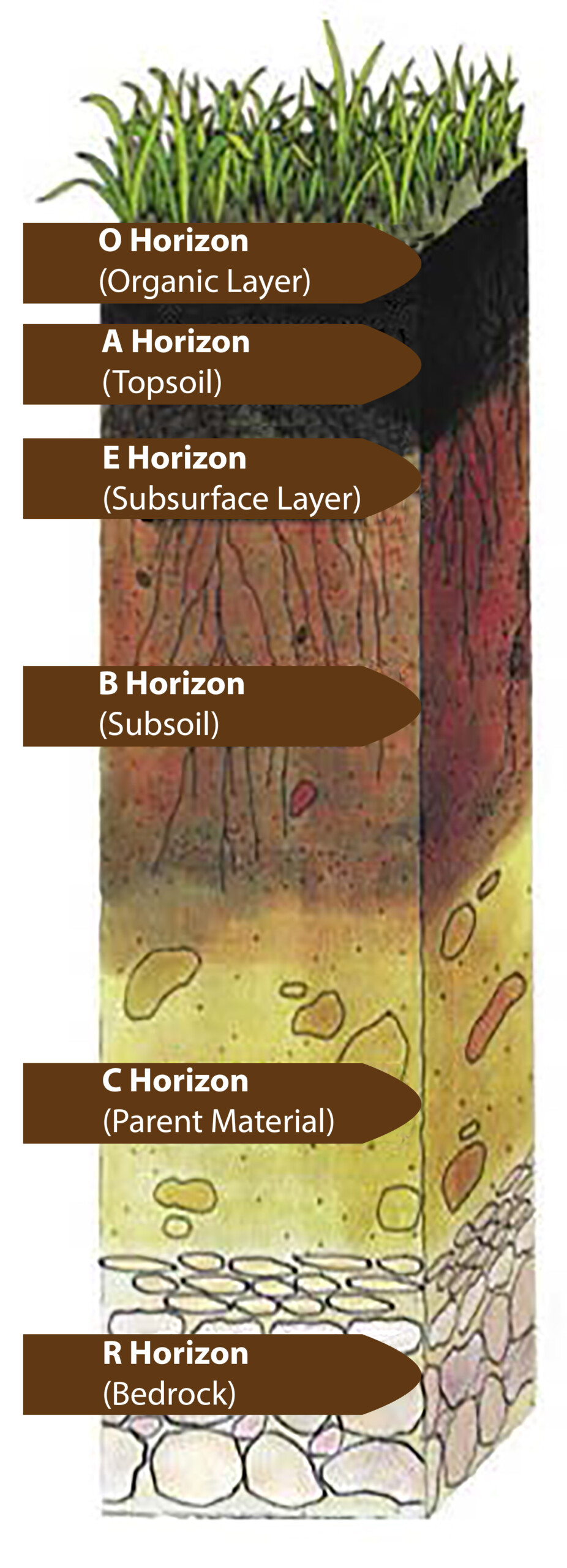by Johann Buck, PhD
This two-part article continues our 2015 series on soil as we recognize the International Year of Soils. In Part 1.1 we define soil and its formation. In Part 1.2 we’ll continue with soil texture, structure, and color.
“Daddy, which is this – soil or dirt?” That’s the question Billy asked his father in one of my favorite The Family Circus comic strips.
Let’s begin with dirt. The word “dirt” is derived from the Old Norse word “drit,” which means excrement. Dirt is what you get under your fingernails or on your clothing or shoes while working in soil.
Several definitions exist for soil. Many of those definitions are, let’s be honest, dull. (Those specific definitions of soil can be found on the USDA Soil Education Web page). The Soil Science Society of America (SSSA) first defines soil as “an amazing substance.” The SSSA continues to define soil as “a complex mix of minerals, air, water, and countless microorganisms, soil forms at the surface of the land and comes in many types.” In other words, soil possesses life, it supports life, and that makes soil exciting!
Okay, so soil is alive and exciting. How does it form? What is it made of? What does it look like?
Soil Formation
CLORPT. No, that word isn’t Klingon: it stands for “Climate, Organisms, Relief (landscape), Parent material, and Time.” These represent the five major soil-forming factors.
“Climate” determines the kind of plant and animal life that reside on and in the soil. Climate also influences soil temperature, the amount of water available for weathering minerals, and the rate of chemical weathering.
“Organisms,” such as plants and animals, contribute to the formation of soil by adding organic matter. Fungal and bacterial microorganisms subsequently break down the organic matter into a semi-soluble material known as humus, while insects, earthworms, and burrowing animals aid in the distribution of humus throughout the soil. Humus contributes to both soil chemical and physical properties. Humus is composed of small particles, which results in high surface area. These small particles contribute to the soil’s ability to supply and retain essential plant nutrients. The presence of humus can also improve soil physical properties such as water-holding capacity. Humus and its benefits will be addressed in subsequent newsletter articles.
The “Relief,” or landscape, includes the slope, aspect, and position of the soil. The steepness, shape, and length of slope affects the way water flows on or off the soil. Aspect is the compass direction that a slope faces and therefore affects soil temperature. North-facing slopes in the United States, generally speaking, are cooler and wetter than south-facing slopes.
“Parent material” is the mineral and organic material from which soil formation begins. The formation of soils is a continuous process that requires thousands of years for significant changes to occur. This is why “Time” is included as one of the five soil-forming factors. It is this weathering of the parent material over time that leads to the development of the soil horizons.

Soil forms in layers, and these layers are often parallel to the soil surface. Technically, these layers are called horizons and their formation is called horizonation. Although these horizons are
related, they differ from each other chemically, physically, and biologically. There are five master horizons, each represented by a letter (see Fig. at left): O, A, E, B, and C. A sixth horizon, represented by the letter R, is used to denote the underlying bedrock. The vertical arrangement of soil horizons is known as the soil profile. Soil profiles vary from location to location, and not all soil profiles possess all five master horizons. (Expanded details for each horizon can be found in the USDA NRCS publication, From the Ground Down.) Soils on older, more stable surfaces will generally possess well-defined soil horizons. The longer a soil has been exposed to events such as rain and plant growth, the more developed the soil profile.
Methodologies exist that scientists use to describe the components and characteristics of the soil profile. These standardized soil-profile descriptions are used to decide how a soil may be used and/or predict how a soil may react to its intended use. Not only are these soil descriptions useful for farmers, they are also useful for civil engineers, ecologists, and hydrologists – to name a few.
Be sure to read part 1.2 of this article in our next newsletter. Keep growing, and make it a good day!
Dr. Buck is North America Director of Technical Services for HUMA GRO®.
Read this and other articles in the Spring 2015 issue of The Solution at http://bhn.uberflip.com/i/513498-bhn-spring-2015-newsletter. Past issues are located at http://bhn.us/newsletters/.
Related Posts

The Huma Gro Farmer Podcast: Episode 6—Biostimulants Regulation – Blog

The Huma Gro Farmer Podcast: Episode 4 – Soil Biology and Soil Health with Promax®
By Jael Batty In Episode 4 of The Huma Gro Farmer podcast, we discuss Soil Biology and Soil Health with Promax®. Promax® is an OMRI-listed organic pesticide that kills soil pathogens and nematodes. Join us as we discuss crop protection with our experts, Bio Huma Netics, Inc. President and CEO Lyndon Smith, and Eastern U.S....


